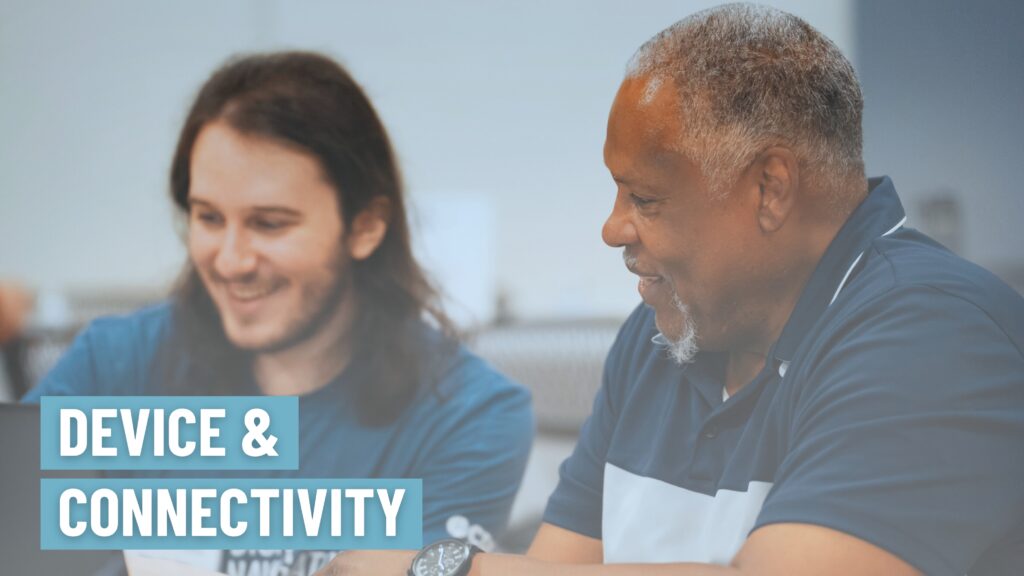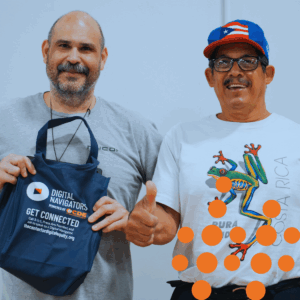
OKR: Achieve a supply of no-cost devices for qualifying residents to increase device ownership across the ecosystem.

5K+ Laptops Distributed to the Community
This year, the CDE took a more intentional approach to device distribution, guided by community feedback and rooted in equity. Instead of scaling for volume alone, we prioritized the right devices, fewer barriers, and the support systems that make technology truly useful. With help from our ecosystem partners, we exceeded our goal, placing over 5,000 laptops into the hands of community members across the region.
Identifying Gaps, Listening for Solutions
To lay the foundation, Senior Program Director Amy Crippen collaborated with partner organizations to understand the specific needs of the populations they serve. These conversations revealed critical differences in how various groups experience and use digital tools:
- Community members who are blind, deaf, or hard of hearing often require specialized, accessible devices.
- Individuals in transitional housing or reentry programs often lack consistent internet access, making prepaid phones a more suitable option during the first 90 days post-release.
- Many organizations highlighted that their clients not only needed devices, but also basic digital skills training to maximize their use.
This feedback shaped both our distribution strategy and our priorities for future planning. It also reinforced that:
There's no one-size-fits-all solution when it comes to digital access. Meaningful support starts by listening.
Evolving Our Model: Distribution Meets Digital Skills
True to our commitment to respond to the needs of the community, we adapted midyear. When partners expressed a growing demand for digital skilling, we introduced a new approach: pairing device distribution with training. Through our already established train-the-trainer model, CDE team members equipped partner organizations to teach digital skills courses alongside devices, creating a more sustainable and empowering model of support.
This shift helped ensure that community members not only received tools but also gained the confidence and knowledge to use them effectively. For partner organizations, it created new capacity to continue digital skilling efforts long after the distribution events ended.
Centering Accessibility and Removing Barriers
To maximize impact and minimize obstacles, we developed a clear set of eligibility guidelines designed to prioritize those with the greatest need:
- Adults age 18 or older, since local students already receive school-issued chromebooks
- Residents of Mecklenburg County, where demand remains high
- Individuals who had not received a laptop from any ecosystem partners in the last year
We intentionally did not require a government-issued ID. Instead, residents only needed to present their name and a device pickup invitation. We also worked to ensure distribution was as accessible as possible:
- Events were hosted in locations easily reachable by public transit
- Residents could schedule pickups during Digital Navigator Office Hours
- We allowed proxies to pick up devices for homebound individuals
This flexibility removed structural barriers and helped ensure that access reached those who might otherwise be left out.
What We Learned—and What Comes Next
This year’s work revealed two key insights that are shaping our goals for the future:
Device Variety Matters. Not everyone needs a laptop, and our work with partners has reinforced the need for a broader pipeline that includes smartphones, tablets, and accessible devices.
Skilling is a critical complement to access. Many community members shared that having a device wasn’t enough on its own—they also needed guidance to navigate digital tools confidently. This insight has already helped inform our expanded training strategy.
As we continue to refine this work, we remain grounded in the belief that access is not just about getting devices into people’s hands but about listening closely, removing barriers, and building systems that support long-term use, learning, and connection.